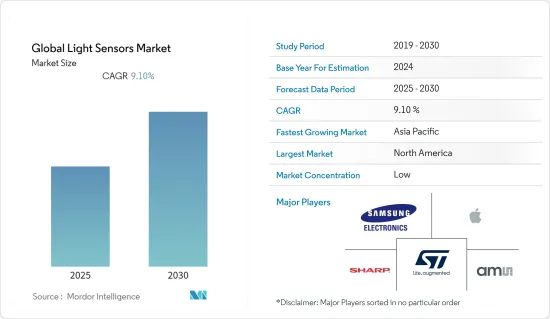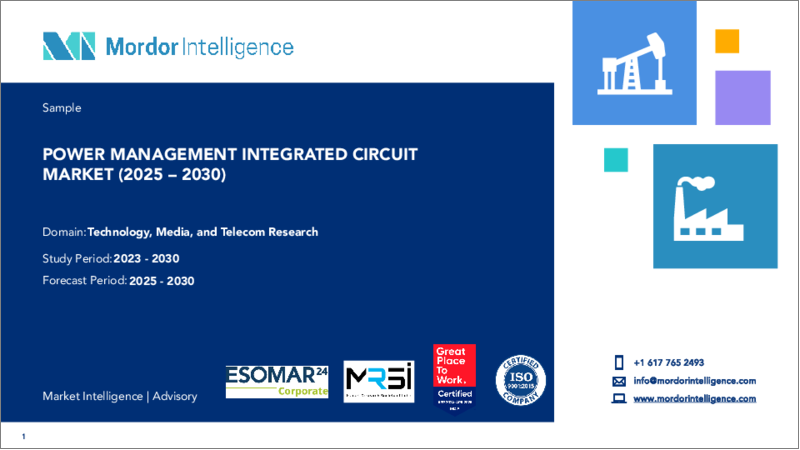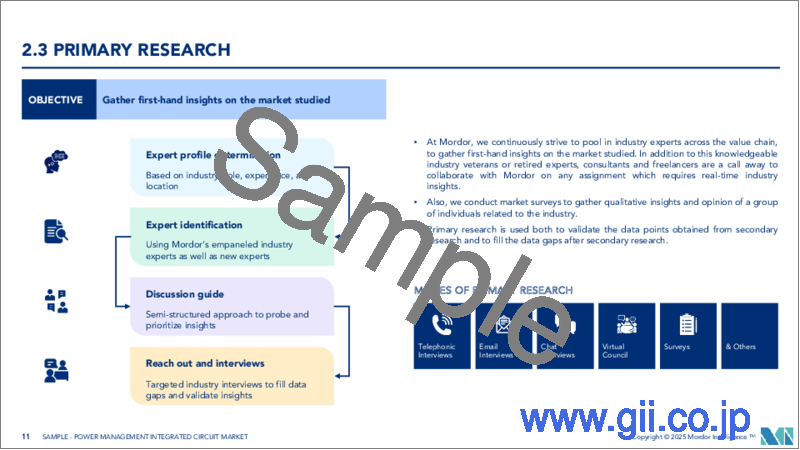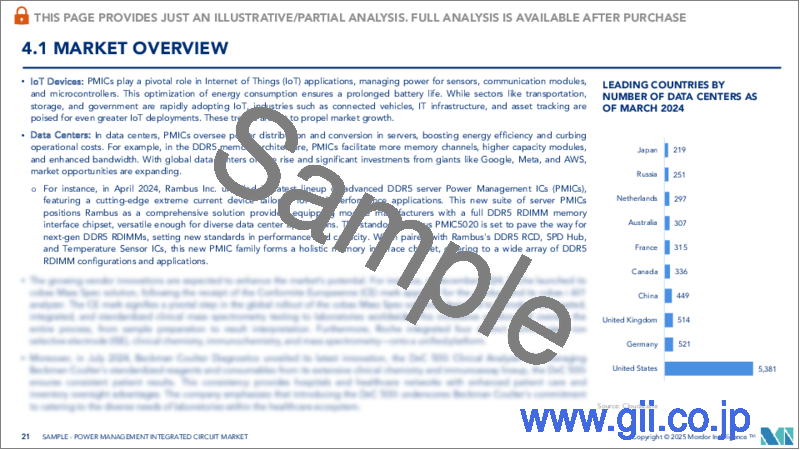|
|
市場調査レポート
商品コード
1630342
世界の光センサ-市場シェア分析、産業動向・統計、成長予測(2025年~2030年)Global Light Sensors - Market Share Analysis, Industry Trends & Statistics, Growth Forecasts (2025 - 2030) |
||||||
カスタマイズ可能
適宜更新あり
|
|||||||
| 世界の光センサ-市場シェア分析、産業動向・統計、成長予測(2025年~2030年) |
|
出版日: 2025年01月05日
発行: Mordor Intelligence
ページ情報: 英文 120 Pages
納期: 2~3営業日
|
全表示
- 概要
- 目次
概要
光センサの世界市場は予測期間中にCAGR 9.1%を記録する見込み

主要ハイライト
- 例えば、近接光センサは、赤外光の変化に反応して、動きや他の物体への近接を検出します。近接光センサは、車両が物体にぶつかりそうになったときにアラームを鳴らす車両の装置に使用されています。近接光センサは、セキュリティ目的で動きを検出するための屋外照明では一般的です。
- スマートフォンメーカーは、製品の品質や視認性を向上させるため、新技術を積極的に機器に取り入れています。例えば、Oppoは2022年4月、同社のモデル「Oppo F21 Pro」に、前世代のIMX615 RGBセンサと比較して、光に対する感度が60%向上し、ノイズが35%低減されたフラッグシップモデルのソニーIMX709 RGBWセルフィーセンサを搭載すると発表しました。
- 自動車セグメントでは、レーンアシスト、自動ヘッドライトなどの新技術の開発に伴い、これらのセンサがバックミラー、室内照明、サイドミラー、レインセンサ、光学式コントロールノブなどに組み込まれています。また、航空宇宙・防衛、回廊マッピング・地形調査、自動車、鉱業、石油・ガスなど、さまざまな産業でLiDARセンサの採用が増加していることも、産業を問わず光センサ市場に成長機会をもたらしています。
- COVID-19パンデミックの間、民生用電子機器部門の成長は急速に変化し、市場参入企業間の競争が激化しました。民生用電子機器メーカーは現在、ユニークで差別化された製品を市場に投入しなければならないという大きなプレッシャーにさらされています。Samsungのような大手スマートフォンメーカーは、光センサメーカーと協力して両技術を統合しています。例えば、2021年11月、MacDermidAlpha Electronics Solutionsは、センシング用途のスペクトル全体にわたって顧客を支援する世界の半導体リーダーであるSTMicroelectronicsと、生産コストを大幅に下げながら車両の効率と航続距離を向上させる電気自動車インバータアセンブリの主要な焼結技術に関する協業を発表しました。
- COVID-19の大流行により、人々の優先順位は技術と健康にシフトし、医療機器などのアプリケーションで環境光センサの需要が増加しています。例えば、Osramは2021年10月、UV-A光を検出するモバイル機器やウェアラブル向けの環境光センサを開発しました。同社によると、太陽光のUV-C部分は地球の大気によって遮断されるが、UV-AとUV-B放射は地表に到達します。日焼けはUV-B放射によって引き起こされるが、UV-Bは皮膚の上層部しか透過しないです。このCOVID-19危機は、企業にとって、人間の手をあまり必要としない技術への投資、実装、研究の機会を提供すると予想されます。例えば、AIと自動化の組み合わせを考えてみよう。
光センサ市場動向
民生用電子機器が大きなシェアを占める見込み
- 光センサ市場における民生用電子機器セグメントの拡大は、モバイル機器における近接センサと環境光センサの使用の増加によって推進されています。Samsung電子を含む大手OEMによる光センサの使用急増により、アジア太平洋は成長の見込みがあります(韓国)。韓国のSamsung電子は光センサ市場の重要な参入企業です。Samsung Galaxy S6やSamsung Galaxy S6 edgeのようなモバイル機器を含む様々な製品カテゴリーに光センサを組み込んでおり、近接検知のような特定のタスクを実行しています。
- LEDテレビ、スマートフォン、スマート照明システムなどのスマートガジェットに対する世界の需要は、小型化とセンサ技術の向上の結果として高まっています。さまざまなセンサ技術と通信インターフェースが、これらのガジェットの中核をなしています。コネクテッド製品や5G通信技術の登場により、さまざまなセンサがセグメント横断的に採用されるようになると予測されます。また、光センサは、住宅用と商業用のウェアラブル・エレクトロニクス機器に頻繁に採用されています。
- スマートフォン、LCD/LEDテレビ、ノートパソコンは、光センサデバイスの需要増加を牽引しているアプリケーションの一部です。センサがこれらの機器の周囲光の量に応じて画面の明るさを自動的に調整する機能を持つ結果、節電が可能になります。照度検出器を含む様々なデジタルセンシング・コンポーネントを利用した照明制御は、現代のIoT照明プラットフォームのもう一つの重点項目です。
- AMS AGの近接検出モジュールと統合型環境光センサは2020年7月に発売され、携帯端末の相手先商標製品製造業者(OEM)は、ほぼベゼルレス画面の携帯端末を作ることができるようになりました。このモジュール(TMD2755)は、市場に出回っている他のデバイスと比較して、面積で40%、体積で60%小さくなっています。さらに、TMD2755は、光センサと近接機能をより薄いベゼルに収めることを可能にすることで、携帯電話メーカーの表示可能領域を拡大する取り組みを支援します。これは、ミッドレンジ市場セグメントの携帯電話に対する消費者の関心が高まっている主要要因として挙げられています。
- 携帯電話、LCD、LEDのような電子機器では、光の量に反応して画面の明るさを自動的に変化させる光センサデバイスの利用が増えています。この機能は、これらの機器の節電に役立っています。光センサは、携帯電話やタブレットなどの民生用電子機器製品で、アクセスや認証、アカウントの利用可能性、セキュリティ/個人情報詐欺防止などのために顔認識を使用することに注目が集まっている結果、この市場で拡大しています。
- ウェアラブルデバイスの採用が急増し、バイオメディカルセグメントでの革新的なアプリケーションが市場の成長を押し上げる可能性があります。しかし、デバイスにセンサを組み込むために発生する余分なコストや、デバイスの寿命が短くなることが、市場成長の妨げになると予想されます。
アジア太平洋が著しい成長率を記録する見込み
- アジア太平洋は、人口規模が大きく、スマートフォンやその他の民生用電子機器製品の需要と生産が増加していることから、光センサ市場を独占すると予想されています。例えば、India Cellular and Electronics Association(ICEA)によると、インドの携帯電話生産額は2019年の1兆7,000億インドルピーから2020年には2兆1,490億インドルピーに増加しました。2021年には、コロナウイルスのパンデミックの影響にもかかわらず、2兆2,270億インドルピーとなりました。
- 光センサ内蔵ハンドヘルドデバイスの採用率の増加も、この地域における光センサ市場の成長に寄与する主要要因の1つです。
- インドや新興諸国などの新興経済諸国では、消費者の間で安全に対する関心が高まっており、自動車メーカーは低価格車に多くのセンサを搭載しています。このことは、当面の間、光センサの需要を促進すると予想されます。
- さらに、モノのインターネット(IoT)、顔認識などの最新技術の採用が重視されるようになり、新興国ではさまざまな業種のセキュリティを強化するための政府規制が、光センサの配備拡大につながっています。
- COVID-19の発生も光センサ市場シェアの成長に影響を与えると見られています。主に中国、日本、シンガポールの政府がスマートシティの開発に投資を始めたためです。さらに、スキャナー、クイックレスポンス(QR)コード、侵入検知システム(IDS)に光センサが広く使用されていることも、市場拡大を後押ししています。
光センサ産業概要
光センサ市場は、多くの大企業や中小企業が市場競争を繰り広げているため、セグメント化されています。製品や技術の発表、戦略的パートナーシップ、買収、事業拡大、競合との競争を通じて、これらの参入企業は市場で競争優位に立とうとしています。
- 2022年7月-Vishay Intertechnology, Inc.のオプトエレクトロニクスグループは、車載、スマートホーム、産業、オフィス用途向けにAEC-Q101認定を受けた新しい反射型光センサを発表しました。Vishay Semiconductors VCNT2025X01は、2.5mm×2.0mm×0.6mmの小型表面実装包装に赤外線エミッタ、シリコン光トランジスタ検出器、昼光遮断フィルタを集積しており、前世代のソリューションよりも薄型でありながら、より高い電流伝達率(CTR)と動作温度で性能向上を実現しています。
- 2021年7月-Sharp Semiconductorは、I2C通信プロトコルに対応したウェアラブル機器向け近接センサGP2AP130S00Fの開発を発表しました。平均消費電流40μA(typ.)の低消費電流設計により、バッテリ電源での長時間動作が可能です。
その他の特典
- エクセル形式の市場予測(ME)シート
- 3ヶ月間のアナリストサポート
目次
第1章 イントロダクション
- 調査の前提条件と市場定義
- 調査範囲
第2章 調査手法
第3章 エグゼクティブサマリー
第4章 市場力学
- 市場概要
- 産業バリューチェーン分析
- 産業の魅力-ポーターのファイブフォース分析
- 供給企業の交渉力
- 消費者の交渉力
- 新規参入業者の脅威
- 代替品の脅威
- 競争企業間の敵対関係
- 市場促進要因
- 自動車セグメントの進歩が市場を後押し
- スマートフォンやPCタブレットへの光センサの搭載拡大
- 市場抑制要因
- 光センサ能力の低さが市場抑制要因に
- 低価格センサが品質低下の脅威を増大
- COVID-19の産業への影響評価
第5章 市場セグメンテーション
- タイプ
- 環境光センサ
- 近接センサ
- RGBカラーセンシング
- ジェスチャー認識
- 紫外線/赤外線(IR)検出
- 出力
- アナログ
- デジタル
- エンドユーザー産業
- 民生用電子機器
- 自動車
- 産業用
- その他
- 地域
- 北米
- 欧州
- アジア太平洋
- ラテンアメリカ
- 中東・アフリカ
第6章 競合情勢
- 企業プロファイル
- AMS AG
- Sharp Corporation
- STMicroelectronics NV
- Broadcom Inc.
- Vishay Intertechnology Inc.
- Apple Inc.
- Elan Microelectronic Corp.
- Everlight Electronics Co. Ltd
- Maxim Integrated Products Inc.
- Samsung Electronics Co. Ltd
- Sitronix Technology Corporation
- ROHM Co. Ltd
第7章 投資分析
第8章 市場機会と今後の動向
目次
Product Code: 69419
The Global Light Sensors Market is expected to register a CAGR of 9.1% during the forecast period.

Key Highlights
- For instance, proximity light sensors respond to changes in infrared light to detect motion or proximity to another object. They are used for devices in vehicles that sound an alarm when the vehicle is close to bumping into an object. Proximity light sensors are common in outdoor lights to detect motion for security purposes.
- Smartphone manufacturers are actively incorporating new technologies into their devices to improve their product quality in terms of product quality and vision. For instance, in April 2022, Oppo announced that its model, Oppo F21 Pro, will feature the flagship Sony IMX709 RGBW selfie sensor that is 60% more sensitive to light and reduces noise by 35% when compared to the previous generation IMX615 RGB sensor.
- In the automotive segment, with the development of new technologies such as lane assist, automatic headlights, and many more, these sensors are being integrated into rear-view mirrors, interior lighting, side-view mirrors, rain sensor, optical control knobs, and many more. Also, the increased adoption of LiDAR sensors in various industry verticals, such as aerospace and defense, corridor mapping and topographical survey, automotive, mining, and oil and gas, has also created growth opportunities for the light sensors market across industries.
- During the Covid-19 pandemic, the consumer electronics sector's growth rapidly changed, increasing competition among market players. Consumer electronics manufacturers are currently under enormous pressure to bring unique and differentiated products to market. Major smartphone manufacturers like Samsung collaborate with light sensor manufacturers to integrate both technologies. For instance, in November 2021, MacDermidAlpha Electronics Solutions announced a collaboration with STMicroelectronics, a global semiconductor leader helping customers across the spectrum of sensing applications, on a key sinter technology for Electric Vehicles inverter assemblies to increase vehicle efficiency and range while lowering production costs significantly.
- Due to the massive COVID-19 outbreak, people's priorities shifted to technology and health, increasing demand for ambient light sensors in applications such as medical devices. For instance, in October 2021, Osram developed an ambient light sensor for mobile devices and wearables that detects UV-A light. According to the company, while the UV-C portion of sunlight is blocked by the earth's atmosphere, UV-A and UV-B radiation reach the earth's surface. Sunburn is caused by UV-B radiation, which only penetrates the upper layers of the skin. This COVID-19 crisis is expected to provide opportunities for businesses to invest in, implement, and research technologies requiring a less human touch. For example, consider the combination of AI and automation.
Light Sensors Market Trends
Consumer Electronics is Expected to Hold a Major Share
- The consumer electronics sector's expansion in the light sensors market has been propelled by the increasing use of proximity sensors and ambient light sensors in mobile devices. Due to a surge in the use of light sensors by the leading OEMs, including Samsung Electronics Co., Ltd., APAC may present prospects for growth (South Korea). The South Korean company Samsung Electronics Co., Ltd. is a significant player in the market for light sensors. It has integrated light sensors into a variety of product categories, including mobile devices like the Samsung Galaxy S6 and Samsung Galaxy S6 edge, that carry out specific tasks like proximity detection.
- Global demand for smart gadgets, such as LED televisions, smartphones, and smart lighting systems, has risen as a result of miniaturization and improvements in sensor technology. Different sensor technologies and communication interfaces are at the heart of these gadgets. The adoption of various sensors across sectors is projected to increase with the advent of connected products and 5G communication technology. Additionally, optical sensors are frequently employed in both residential and commercial wearable electronics equipment.
- Smartphones, LCD/LED televisions, and laptops are some of the applications that are driving the increase in demand for light sensor devices. As a result of the sensors' ability to automatically adjust the screen brightness based on how much ambient light these devices get, electricity savings are made possible. The control of lighting utilizing various digital sensing components involving illuminance detectors is another key emphasis of contemporary IoT lighting platforms.
- The proximity detection module and integrated ambient light sensor from AMS AG were released in July 2020, enabling mobile handset Original Equipment Manufacturers (OEMs) to create mobile handsets with almost bezel-less screens. In comparison to other devices on the market, the module (TMD2755) is 40% lower in area and 60% smaller in volume. Moreover, TMD2755 aids mobile phone manufacturers' efforts to expand the viewable display area by allowing the light-sensing and proximity features to be contained in a thinner bezel. This has been cited as a major contributor to rising consumer interest in mobile phones in the mid-range market segment.
- Electronic devices like mobile phones, LCDs, and LEDs are increasingly using light sensor devices to automatically alter the screen brightness in reaction to the quantity of light they are exposed to. This capability helps these devices conserve electricity. Light sensors are expanding in this market as a result of the growing focus on using facial recognition in consumer electronics, such as mobile phonesand tablets, for access and authentication, account accessibility, and security/identity fraud protection.
- The surge in the adoption of wearable devices and innovative applications in the biomedical sector may boost the growth of the market. However, the extra costs incurred due to the incorporation of sensors in devices and reduction in the life of the device are expected to hinder the market growth.
Asia-Pacific is Expected to Register a Significant Growth Rate
- Asia-Pacific is expected to dominate the light sensors market, owing to its larger population size and increasing demand and production of smartphones and other consumer electronics. For instance, according to India Cellular and Electronics Association (ICEA), the value of mobile phone production in India increased from INR 1,700 billion in 2019 to INR 2,149 billion in 2020. In 2021, the value totaled to INR 2,227 billion, despite the impact of the coronavirus pandemic.
- An increase in the adoption rate of handheld devices with inbuilt light sensors is also one of the key factors contributing to the growth of the light sensors market in the region.
- With an increase in the safety concerns among the consumers in the developing economies, such as India and the ASEAN countries, the automobile manufacturers are incorporating more sensors in low-cost vehicles. This is expected to drive the demand for light sensors in the foreseeable future.
- Further, the growing emphasis on the adoption of the latest technologies, such as the Internet of Things (IoT), facial recognition, and government regulations in the emerging economies to enhance security across various industry verticals are leading to increased deployment of light sensors, which is, in turn, boosting the growth of the industry in the region.
- The COVID-19 outbreak is also expected to impact the growth of the Light sensors market share. Primarily due to the governments in China, Japan, and Singapore starting to invest in the development of smart cities. Furthermore, the widespread use of light sensors in scanners, Quick Response (QR) codes, and intrusion detection systems (IDS) is driving market expansion.
Light Sensors Industry Overview
The light sensors market is fragmented, due to many large and small players churning the competition in the market. Through product and technology launches, strategic partnerships, acquisitions, expansions, and collaborations, these players are trying to gain a competitive edge in the market.
- July 2022 - The Optoelectronics group of Vishay Intertechnology, Inc. introduced a new AEC-Q101-qualified reflective optical sensor for automotive, smart home, industrial, and office applications. Offering a lower profile than previous-generation solutions while delivering improved performance with a higher current transfer ratio (CTR) and operating temperature, the Vishay Semiconductors VCNT2025X01 integrates an infrared emitter, silicon phototransistor detector, and daylight blocking filter in a miniature 2.5 mm by 2.0 mm by 0.6 mm surface-mount package.
- July 2021 - Sharp Semiconductor Co., Ltd. announced the development of the GP2AP130S00F proximity sensor for wearable devices that supports the I2C communication protocol. Its low current consumption design with an average current consumption of 40 μA (typ.) enables long-duration operation on battery power.
Additional Benefits:
- The market estimate (ME) sheet in Excel format
- 3 months of analyst support
TABLE OF CONTENTS
1 INTRODUCTION
- 1.1 Study Assumptions and Market Definition
- 1.2 Scope of the Study
2 RESEARCH METHODOLOGY
3 EXECUTIVE SUMMARY
4 MARKET DYNAMICS
- 4.1 Market Overview
- 4.2 Industry Value Chain Analysis
- 4.3 Industry Attractiveness - Porter's Five Forces Analysis
- 4.3.1 Bargaining Power of Suppliers
- 4.3.2 Bargaining Power of Consumers
- 4.3.3 Threat of New Entrants
- 4.3.4 Threat of Substitutes
- 4.3.5 Intensity of Competitive Rivalry
- 4.4 Market Drivers
- 4.4.1 Advancements in the Automotive Sector Fuel the Market
- 4.4.2 Growing Implementation of Light Sensors in Smartphones and PC Tablets
- 4.5 Market Restraints
- 4.5.1 Low Light Sensing Capabilities Act as a Restraining Factor
- 4.5.2 Low-cost Sensors are Increasing the Threat to Scale Down the Quality
- 4.6 Assessment of the Impact of COVID-19 on the Industry
5 MARKET SEGMENTATION
- 5.1 Type
- 5.1.1 Ambient Light Sensing
- 5.1.2 Proximity Detector
- 5.1.3 RGB Color Sensing
- 5.1.4 Gesture Recognition
- 5.1.5 UV/Infrared Light (IR) Detection
- 5.2 Output
- 5.2.1 Analog
- 5.2.2 Digital
- 5.3 End-user Industry
- 5.3.1 Consumer Electronics
- 5.3.2 Automotive
- 5.3.3 Industrial
- 5.3.4 Other End-user Industries
- 5.4 Geography
- 5.4.1 North America
- 5.4.2 Europe
- 5.4.3 Asia-Pacific
- 5.4.4 Latin America
- 5.4.5 Middle-East and Africa
6 COMPETITIVE LANDSCAPE
- 6.1 Company Profiles
- 6.1.1 AMS AG
- 6.1.2 Sharp Corporation
- 6.1.3 STMicroelectronics NV
- 6.1.4 Broadcom Inc.
- 6.1.5 Vishay Intertechnology Inc.
- 6.1.6 Apple Inc.
- 6.1.7 Elan Microelectronic Corp.
- 6.1.8 Everlight Electronics Co. Ltd
- 6.1.9 Maxim Integrated Products Inc.
- 6.1.10 Samsung Electronics Co. Ltd
- 6.1.11 Sitronix Technology Corporation
- 6.1.12 ROHM Co. Ltd





